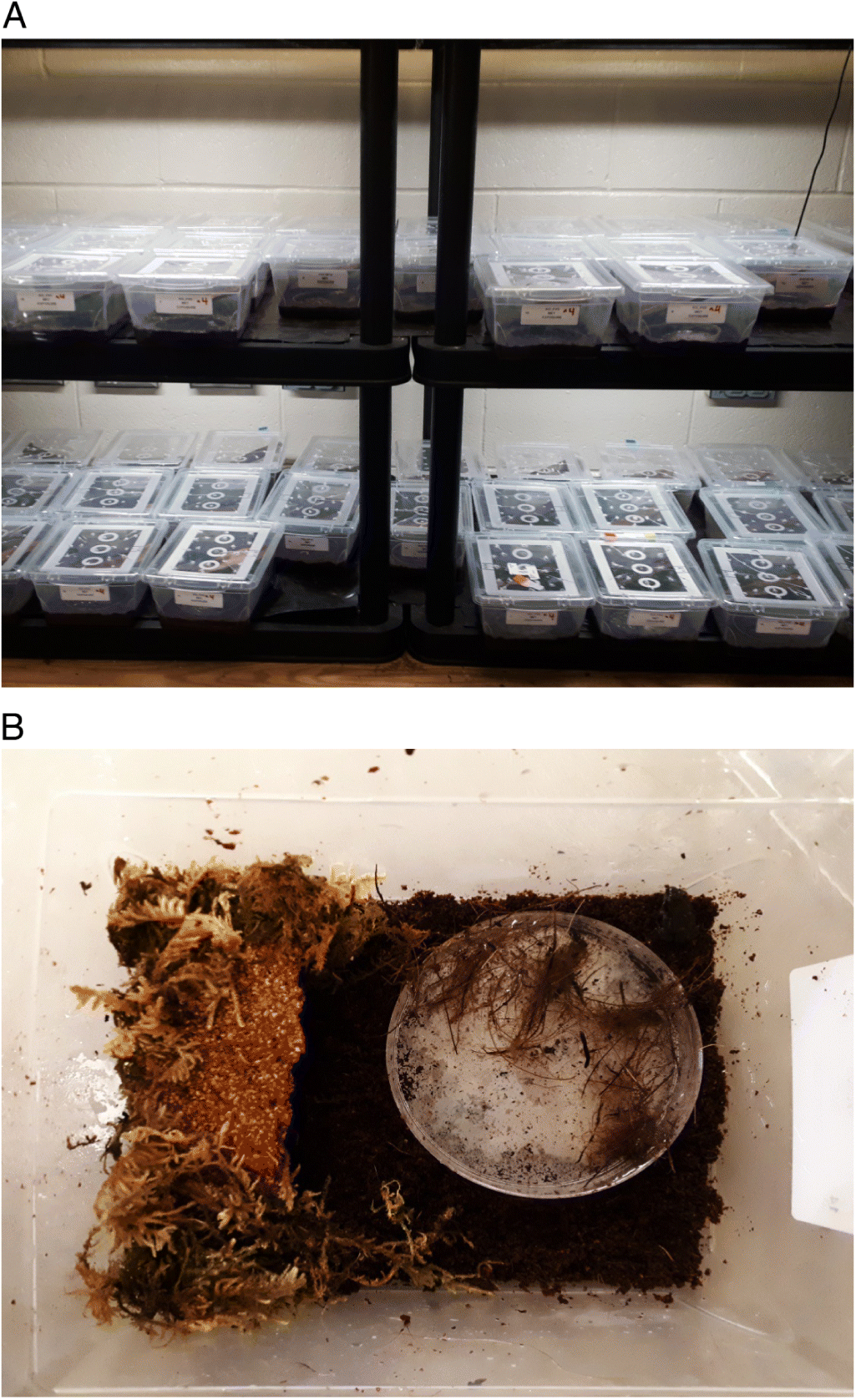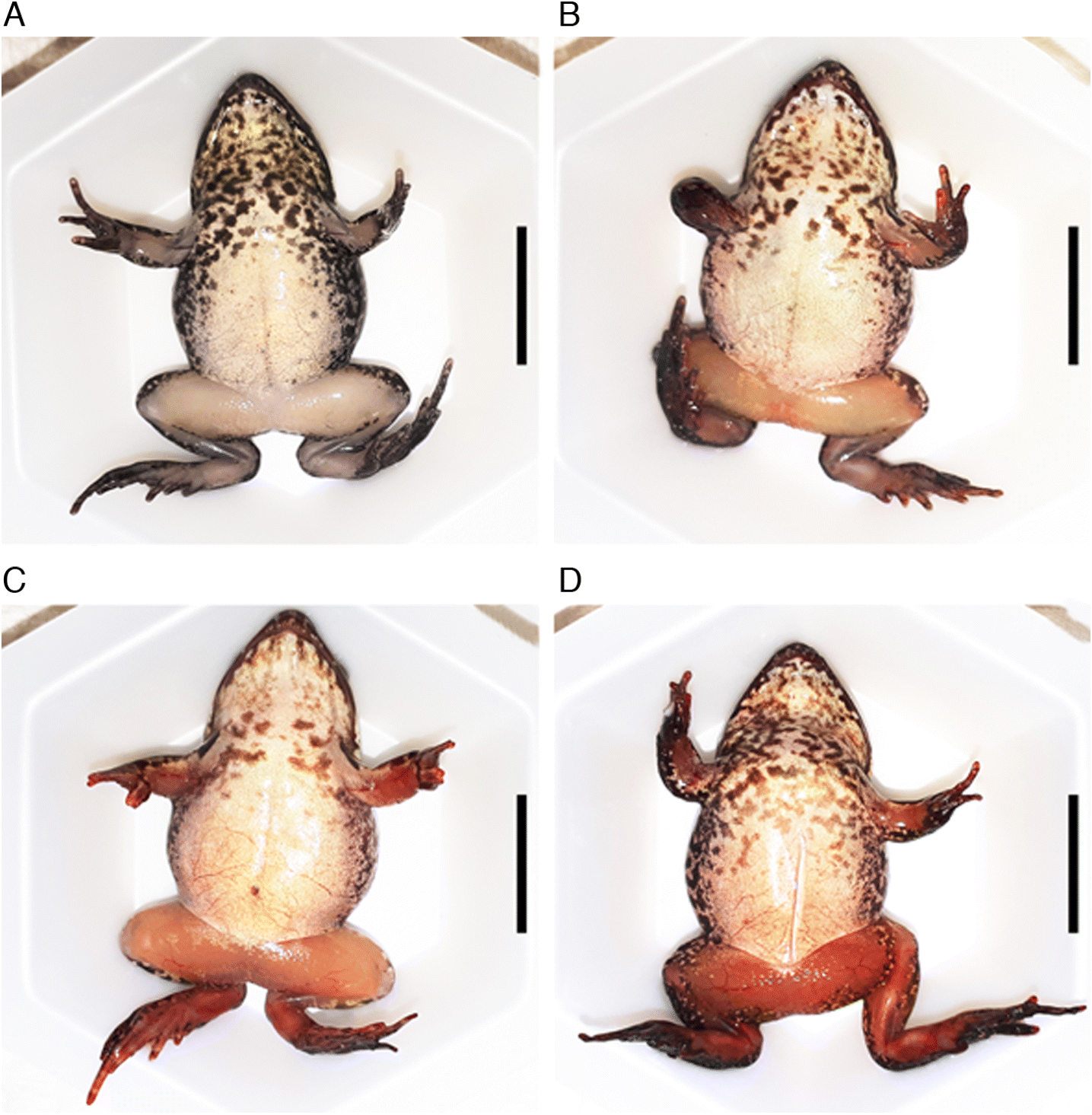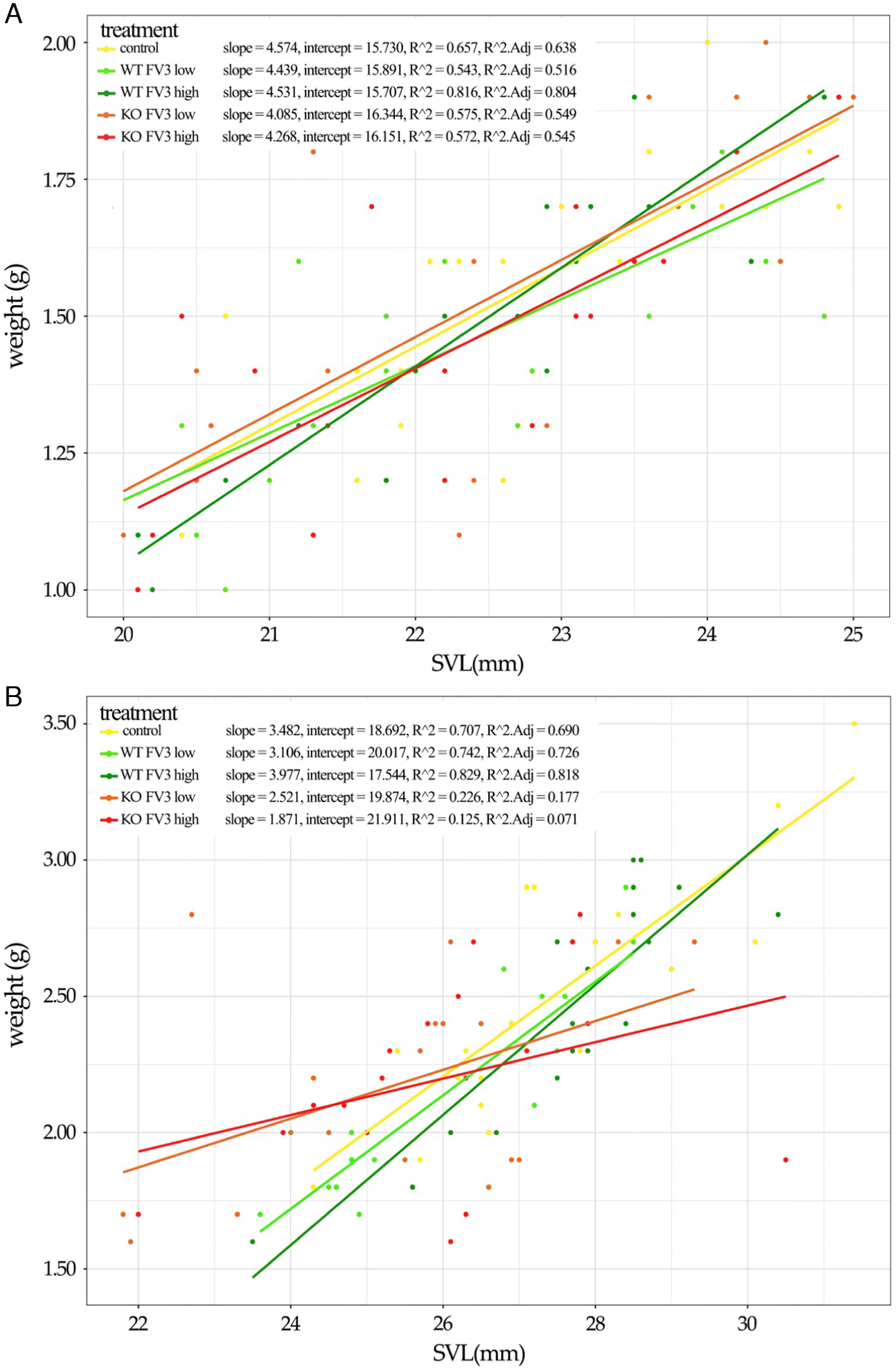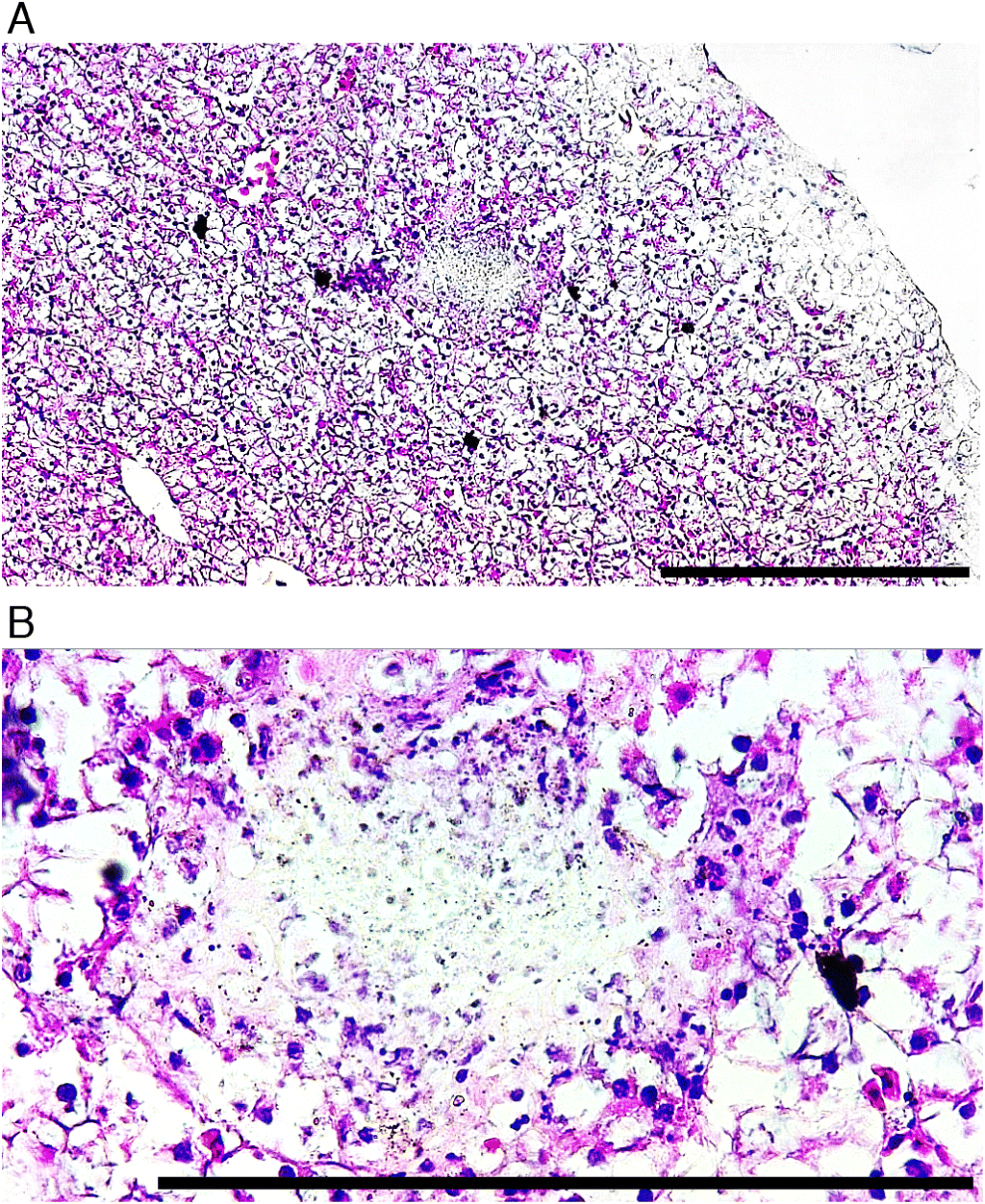Introduction
Viruses belonging to the genus
Ranavirus within the family Iridoviridae (
Chinchar et al. 2017) are believed to be responsible for serious mass mortality events in wild and captive amphibians, fish, and reptiles by causing a systemic disease involving necrosis of hepatic, nephritic, and gastrointestinal tissues (
Duffus et al. 2015;
Miller et al. 2015).
Ranavirus species are highly variable in their virulence (e.g.,
Schock et al. 2008,
2009;
Echaubard et al. 2010;
Hoverman et al. 2010) and have not been thoroughly studied outside of postmortem amphibians. Typically they depend on the susceptibility of the host species and the identity of the viral strain involved (e.g.,
Schock et al. 2008,
2009;
Echaubard et al. 2010;
Hoverman et al. 2010). Amphibians exhibit considerable interspecific variation in susceptibility to ranavirus infections in general (
Schock et al. 2008;
Hoverman et al. 2010), but intraspecific variation in susceptibility and infection severity among life stages also plays an important role in pathogen dynamics (
Brunner et al. 2004;
Echaubard et al. 2010). Many larval amphibians show a high probability of developing lethal ranavirosis (e.g.,
Gray et al. 2009a;
Hoverman et al. 2011;
Jensen et al. 2011), which coincides with observations of die-offs in late stage tadpoles or newly metamorphosed individuals (
Converse and Green 2005;
Greer et al. 2005). Therefore, ranaviruses likely require reservoirs such as sublethal infected individuals to persist in amphibian communities (
Brunner et al. 2004;
Duffus et al. 2008;
Gray et al. 2009a). Yet, despite the probable importance of postmetamorphic life stages in the epidemiology of amphibian ranaviruses, there is little information from which to draw inferences (
Bayley et al. 2013;
Sutton et al. 2014;
Forzán et al. 2015).
Frog virus 3 (FV3), the type species of the genus
Ranavirus, is known to have a serious impact on amphibian populations worldwide (
Chinchar et al. 2009), especially in North America, (
Duffus et al. 2008;
Gray and Chinchar 2015) and is the best described member of the genus. Full genomes of several FV3 isolates have been sequenced, the elemental features of viral replication are known, and 98 open reading frames (ORFs) have been identified (
Chen et al. 2011). These conserved protein-coding regions are likely involved in virulence, host tropism, and immune evasion and suppression strategies (
Andino et al. 2015), but the specific functional role is currently only known for a few FV3 ORFs (
Tan et al. 2004). By creating gene-knockout mutants, and conducting subsequent experimental challenges of
Xenopus laevis tadpoles,
Chen et al. (2011) identified the vIF-2α gene, which plays a crucial role in viral virulence by suppressing the host antiviral response (
Andino et al. 2015). Interestingly, in comparison to other
Ranavirus species, the FV3 vIF-2α gene exhibits a truncation in its N-terminal region (
Chen et al. 2011). The truncated gene suppresses the type I and type III interferon (IFN) response in larvae of the model species
Xenopus laevis (
Grayfer et al. 2015a), but the in vivo effects have not been studied in any postmetamorphic anuran. Since the amphibian immune system develops and changes from larval to adult stages (
Grayfer et al. 2015b;
Wendel et al. 2017), this gap in knowledge limits our understanding of the role played by the vIF-2α gene in ranavirus infection dynamics.
To investigate ranavirus infection in postmetamorphic amphibians, we exposed terrestrial wood frogs (
Rana sylvatica) via bath exposure to environmentally relevant concentrations (
Gray et al. 2009a) of two isolates of
Ranavirus: FV3 wild-type (WT) and the FV3 vIF-2α knockout (KO) as described by
Chen et al. (2011). We focused our study on wood frogs because FV3-related mortality events in wild anurans in North America are often associated with communities containing this species (e.g.,
Greer et al. 2005;
Brunner et al. 2011;
Forzán et al. 2019), suggesting this species to be an important host for FV3. Further, wood frogs have been suggested as a model species for challenge experiments involving North American strains of
Ranavirus due to their widespread distribution, sympatry with numerous other amphibian species, and relatively high ranavirus prevalence levels (
Lesbarrères et al. 2012;
Forzán et al. 2015).
Discussion
Ranavirus induced mortality was very low (5%) in postmetamorphic wood frogs when exposed to environmentally relevant concentrations of ranavirus via water bath, and only 42% of the frogs tested positive for ranavirus across the virus treatments at the end of the 40-d experiment. Infection rates and viral loads followed a dose-dependent pattern, but we did not observe any significant differences in mortality between the virus treatments. The observed times to death (8–11 d) were consistent with other studies on postmetamorphic individuals (e.g.,
Bayley et al. 2013;
Forzán et al. 2015), and although there was abundant gross pathological evidence of infection within the first 2 weeks postexposure, most individuals showed no or minor signs of infection at the end of the trial.
The overall low infection and mortality rates may be a consequence of selection towards more resilient genetic lineages within the source population, induced by repeated exposure to the pathogen (
Pearman and Garner 2005). The genetic composition of distinct populations may have significant impact on the outcomes of a ranavirus emergence (
Echaubard et al. 2014), and a co-evolutionary history of the host immune system with the pathogen may have led to decreased susceptibility to re-introduced pathogens or strains thereof (
Pearman and Garner 2005). All wood frogs used in our study were raised from four egg clutches collected from a natural population within Wood Buffalo National Park that showed low ranavirus prevalence and low viral loads in 2017 (
Bienentreu 2019). However, ranavirus has been frequently detected in amphibians in the area (
Bienentreu 2019), with two confirmed die-off events in 2017 at wetlands located 7 and 29 km away from the sampled population (
Forzán et al. 2019) and mortality occurring among wood frog tadpoles within 3.5 km in 2009 (D.M. Schock, unpublished work). Additionally, viral isolate sequencing led to the identification of at least two different FV3-like viruses prevailing in this area (
Grant et al. 2019;
Vilaça et al. 2019). These observations, in combination with our experimental results, could indicate that the source population evolved partial immunity against FV3-like ranaviruses due to repeated exposures to the pathogen.
An alternative explanation for the observations made in our experiment may be linked to the immune status of the postmetamorphic individuals. Experimental studies conducted with different life stages of the model species
Xenopus laevis identified significant differences in the antiviral responses mounted by tadpoles and adult frogs to FV3, presumably reflecting the morphological and immunological differences between pre- and postmetamorphic anurans (
Grayfer et al. 2015b;
Wendel et al. 2017). Gene expression studies showed that tadpoles exhibit considerably less robust and delayed anti-FV3 inflammatory gene responses relative to adults (
Andino et al. 2012), although they have rather timely antiviral (type III IFN) responses to this pathogen (
Grayfer et al. 2015a;
Wendel et al. 2017). Further, postmetamorphic
X. laevis are capable of clearing FV3 infection within one month after exposure (
Gantress et al. 2003). Therefore, our results may be an underestimate of the actual infection rates and viral loads that occurred over the duration of the entire experiment. Frogs that persistently exhibited gross signs of infection until the end of the study had low viral loads but showed severe hepatocellular necrosis. Perhaps a considerably greater proportion of the frogs exposed to virus in our study became infected with FV3, but subsequently reduced FV3 levels in their liver tissues below the detection capabilities of the methods employed here. This possibility is consistent with our observations that 81% of the frogs that exhibited gross signs of infection in the first two weeks postexposure were apparently healthy by the end of the experiment, and only 42% tested positive for the virus. We chose to focus on liver tissues because the gastrointestinal system and, in particular, the liver are commonly affected in ranavirus infections (
Forzán et al. 2015;
Miller et al. 2015). However, histological evidence of FV3 infections in adult wood frogs indicates that the virus can also persist in bone marrow and organs of the lymphatic and urinary system (
Forzán et al. 2015). All four animals (one per virus treatment) that died late in the study tested negative for FV3 in their livers via qPCR, but two of the four exhibited signs of infection in the first two weeks of the experiment. Some or all of these frogs may sustained tissue damage in other organs, ultimately resulting in their death, as found by
Grayfer et al. (2014) using FV3 in
X.
laevis. We did not detect any histological lesions in liver tissues of these four animals, and unfortunately, we were unable to examine other tissues for lesions. Thus, it remains unknown whether FV3 was in other tissues of these four frogs.
FV3 infects a wide variety of cold-blooded vertebrates which possess a myriad of immune systems and broad differences in their respective antiviral immune responses. We know relatively little about the evolutionary origins of this pathogen and which of its aquatic vertebrate host immune system(s) this virus has coevolved with. Thus, it stands to reason that the FV3 immune evasion mechanisms are best suited for interacting with immune proteins of those species in the context of which the virus has evolved. For example, the FV3 vIF-2α is a better decoy substrate for the RNA-induced protein kinase R (PKR) of some species over others (
Andino et al. 2015;
Grayfer et al. 2015a). While the WT and KO FV3 clearly possess broad immune evasion differences in other amphibian species (
Andino et al. 2015;
Grayfer et al. 2015a), the fact that we did not see marked differences between WT and vIF-2α KO FV3 infections of wood frogs may indicate that the FV3 vIF-2α is less effective or compatible with the wood frog immune system in general and with these frogs PKR in particular. In fact,
R.
sylvatica is considerably resistant to this FV3 possibly reflecting that FV3 did not coevolve with this species or related ones and is thus less effective at infecting it. In general, the magnitudes of FV3 loads do not as clearly correlate with infection outcomes, as is commonly seen with other viral infections (
Grayfer et al. 2014). For example, infected adult
X.
laevis have been shown to hold considerably higher viral loads than tadpoles (
Grayfer et al. 2015a;
Wendel et al. 2017), even though tadpoles typically succumb to ranavirosis (
Landsberg et al. 2013;
Reeve et al. 2013;
Grayfer et al. 2014). Since the wood frogs used in our experiment experienced low mortality and signs of ranavirosis are often exhibited even at low titers (
Grayfer et al. 2014), the differences in the viral loads would not necessarily be reflected in animal survival. Furthermore, viral loads were solely examined from liver tissue and no other organs were screened in this study. It has been shown that kidney and liver FV3 loads can differ in
X. laevis tadpoles and that immune modulation has different effects on the FV3 loads in different tissues of these animals (
Grayfer et al. 2015a). Thus, it is possible that the replication of vIF-2α KO FV3 may be more immunologically restricted in distinct tissue(s) other than the liver. If this is the case in wood frogs, FV3 loads of WT and KO infected animals could have differed in organs other than the liver.
Notably, wood frogs exposed to the KO FV3 showed lower activity and decreased growth, as well as slightly higher mean viral loads in the high-dose treatment, compared with wood frogs exposed to the WT FV3. These effects are potentially due to energetically costly specific immune responses. Vertebrate antiviral defenses are highly dependent on IFN cytokine-mediated immunity. Recent in vitro studies suggest that the FV3 vIF-2α gene product is crucial to counteracting the host IFN-induced antiviral states (
Grayfer et al. 2015a).
Andino et al. (2015) showed that the KO FV3 exhibited reduced replication in vitro in the immuno-competent
X. laevis A6 kidney epithelial cell line and elicited less pronounced type I and III IFN responses in A6 cultures, compared with the wild type FV3. Interestingly, when the A6 cell IFN responses elicited by the KO FV3 were reassessed as a function of the viral loads in those cultures, the KO FV3 elicited proportionately greater IFN responses than the WT FV3 (L. Grayfer, unpublished work). This, in turn, confirms that despite deletions in its N-terminal region, the FV3 vIF-2α gene product is crucial to dampening the frog host IFN responses (
Grayfer et al. 2015a). While the functional significance of the truncation remains to be fully understood, our results indicate that this FV3 gene plays an important role in evading the host antiviral IFN response. We thus hypothesize that the lower activity and the decreased growth we observed in wood frogs infected with the vIF-2α KO FV3 reflect their more pronounced, and thus presumably more energetically costly, cytokine responses relative to animals infected with WT FV3. Conversely and as proposed above, the lack of significant viral load and mortality differences between WT- and vIF-2α KO FV3-infected animals could be attributed to less effective (albeit some) WT FV3 vIF-2α–host immune system (PKR) interactions. Alas, these hypotheses remain speculative in the absence of comprehensive immunological data.
Sample sizes in our experiment were based on other studies determining ranavirus susceptibility on species level (e.g.,
Hoverman et al. 2010;
Sutton et al. 2014;
Forzán et al. 2015), that showed that sample sizes of 20 individuals per treatment are sufficient to observe differences among treatments. The concentrations used were based on environmentally relevant concentrations of ranavirus virions (10
3–10
4 PFU/mL;
Rojas et al. 2005;
Gray et al. 2009a). Other studies using FV3 or FV3-like viruses with similar concentrations and bath exposure observed high mortality (97% and 100% for
R.
temporaria and
R.
servosus, respectively;
Bayley et al. 2013;
Sutton et al. 2014) highlighting the high variance in species susceptibility (
Hoverman et al. 2010). Postmetamorphic wood frogs orally inoculated with similar FV3 concentrations showed 80%–100% mortality, and the odds of dying increased 23-fold for every tenfold increase in concentration, with death occurring approximately 15% earlier (
Forzán et al. 2015). This suggests that mortality rates are concentration and route-specific, even within the same host species.
Identifying reservoirs that allow the pathogen to persist in the environment and facilitate its spread in animal communities remains a challenge of modern epidemiology. Using wood frogs, the most widely distributed amphibian species in North America (
Martof 1970), we document important in vivo effects of infection of WT FV3 and KO FV3 in postmetamorphic wood frogs, contributing to the overall knowledge on infection in adult anurans and highlighting the function of the vIF-2α gene in ranavirus pathogenesis. Moreover, low viral loads in infected individuals underline the importance of high-sensitivity pathogen screening (
Greer and Collins 2007), and provide evidence that even short duration exposures to environmentally relevant concentrations of ranavirus may cause sublethal infections in postmetamorphic wood frogs, indicating the role of this stage as a plausible reservoir for FV3 and possibly for ranavirus in general.





